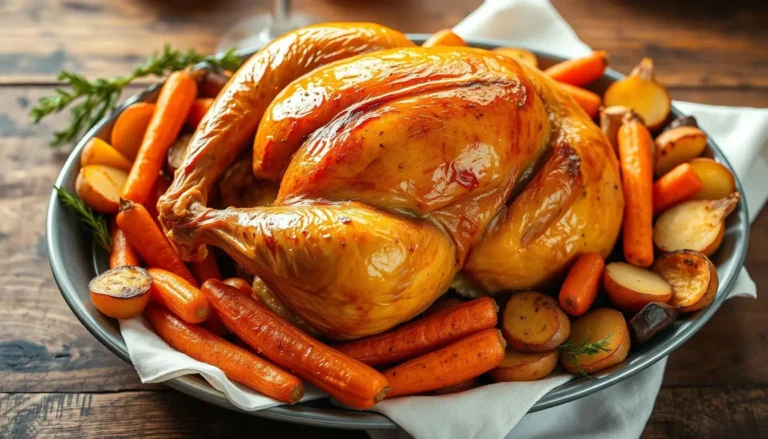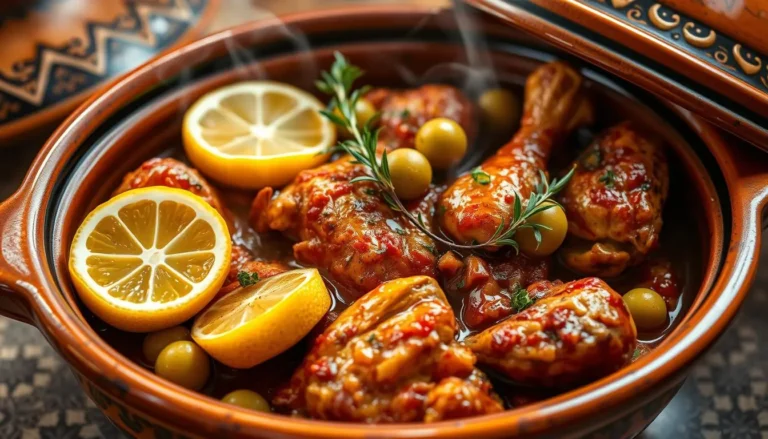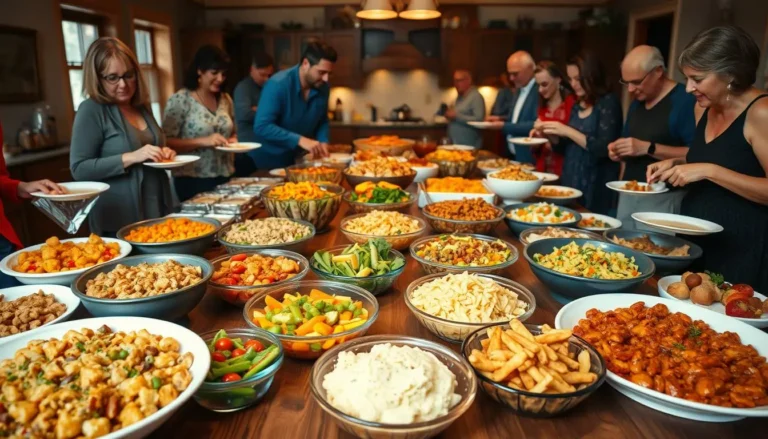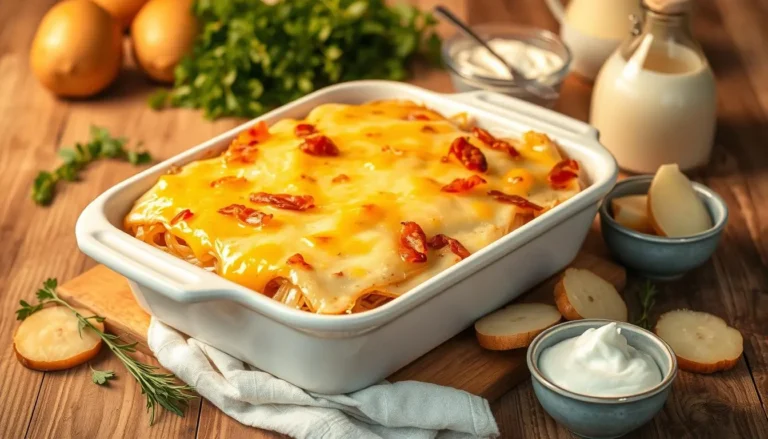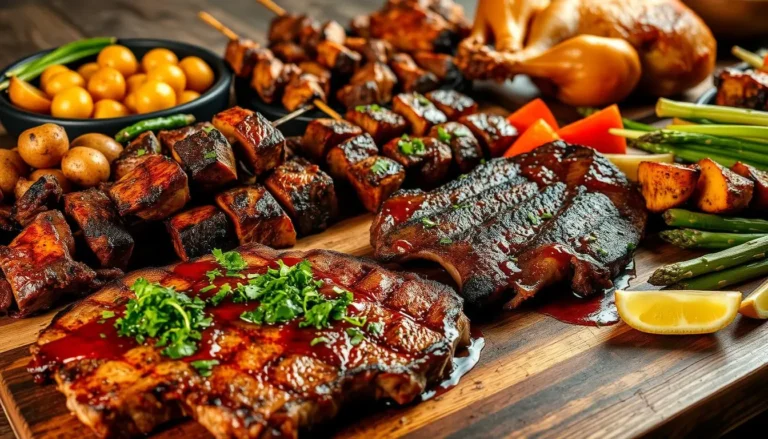Charcoal Grill Tips for Delicious Outdoor Cooking

Charcoal Grill Tips
There’s something special about cooking outdoors, isn’t there? The sizzle of food on the grill, the aroma that fills the air, and the joy of sharing a meal with family and friends. For many, charcoal grilling is the preferred method, as it adds a unique, smoky flavor to dishes.
In places like Australia, grilling on charcoal is a popular pastime, and it’s easy to see why. The process not only enhances the flavor but also creates an experience. Whether you’re a seasoned grill master or just starting out, understanding the best practices can elevate your outdoor cooking.
By mastering a few simple techniques, you can achieve delicious results that will impress your guests and leave everyone wanting more.
Table of Contents
Key Takeaways
- Understand the basics of charcoal grilling for better flavor.
- Learn how to effectively use your charcoal grill.
- Discover tips for achieving that perfect smoky taste.
- Improve your outdoor cooking with best charcoal grill practices.
- Enhance your grilling experience with simple techniques.
The Fundamentals of Charcoal Grill Tips
To master charcoal grilling, you first need to understand its fundamentals. Charcoal grilling is a cooking method that involves burning charcoal to cook food, and it’s known for the rich, smoky flavor it imparts. Charcoal is made by burning hardwood at high heat in a low-oxygen environment until it carbonizes.
How Charcoal Creates That Perfect Flavor
The unique flavor of charcoal-grilled food comes from the Maillard reaction, a chemical reaction between amino acids and reducing sugars that occurs when food is cooked, especially over high heat. Charcoal enhances this reaction by adding a smoky flavor. The type of charcoal used can also impact the flavor, with lump charcoal providing a more natural, smoky taste compared to briquettes.
Kettle vs. Barrel vs. Kamado Grills
There are several types of charcoal grills available, each with its own advantages. Kettle grills are versatile and great for beginners, barrel grills offer more space for larger gatherings, and kamado grills provide excellent heat retention and control. “The right grill for you depends on your grilling needs and preferences,” as charcoal grilling experts would say.
Why Charcoal Outshines Gas for Flavor
Charcoal grilling is often preferred over gas grilling because of the rich, smoky flavor it provides. As
“Charcoal gives food a depth of flavor that gas simply can’t match,”
a renowned chef once noted. The high heat and smoke from charcoal contribute to a more complex flavor profile, making it a favorite among grill enthusiasts.
Essential Charcoal Grill Tips for Perfect Results
Elevate your outdoor cooking with these essential charcoal grill tips for perfect results every time. Achieving delicious and consistent results with your charcoal grill requires attention to detail and a few expert techniques. By following these tips, you’ll be well on your way to becoming a charcoal grilling expert.
Choosing Between Lump and Briquette Charcoal
The type of charcoal you use can significantly impact the flavor and quality of your grilled food. Lump charcoal is known for its natural, smoky flavor and is often preferred by grilling enthusiasts. On the other hand, briquette charcoal provides a more consistent burn and is generally easier to find. When choosing between the two, consider your grilling style and the type of food you’re cooking.
Lump charcoal is ideal for high-heat grilling and provides a more authentic, smoky flavor. Briquette charcoal, however, is better suited for longer, low-and-slow cooking sessions due to its consistent burn.
Setting Up Your Grill for Success
Properly setting up your grill is crucial for achieving perfect results. Start by ensuring your grill is clean and free of debris. Next, arrange your charcoal in a way that allows for good airflow, which is essential for maintaining a consistent temperature. You can use a charcoal chimney to make this process easier and more efficient.
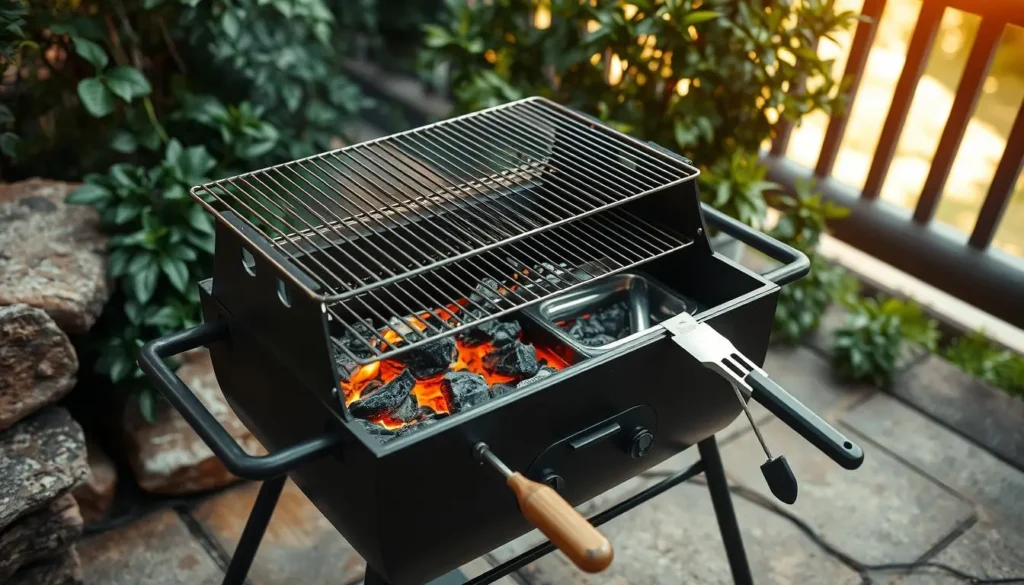
Chimney Starters vs. Lighter Fluid
When it comes to lighting your charcoal, you have two main options: chimney starters and lighter fluid. Using a charcoal chimney is a simple and effective way to get started with charcoal grilling. It’s essential to wait until the charcoal is fully gray-white hot before adding it to the grill. This method is not only safer but also helps to avoid imparting a chemical flavor to your food.
Preheating Your Grill Properly
Preheating your grill is a critical step that is often overlooked. To preheat your grill properly, allow it to heat up for at least 15-20 minutes with the lid closed. This ensures that the grill grates are hot and ready for cooking, which helps to achieve a perfect sear on your food. Make sure to adjust the vents as needed to maintain the desired temperature.
Mastering Temperature Control on Your Charcoal Grill
To elevate your grilling game, it’s essential to understand how to effectively manage the temperature on your charcoal grill. Temperature control is a critical aspect of charcoal grilling, as it directly impacts the quality and flavor of your grilled foods. By mastering temperature control, you can achieve perfectly cooked meals every time.
Creating and Using Heat Zones Effectively
Creating heat zones on your charcoal grill allows you to cook different types of food simultaneously, each at its ideal temperature. This is achieved by adjusting the distribution of charcoal and controlling airflow. For example, you can create a hot zone for searing steaks and a cooler zone for cooking vegetables or finishing off larger cuts of meat. Effective heat zoning is key to versatile and efficient grilling.
Adjusting Vents for Perfect Temperature
Adjusting the vents on your charcoal grill is crucial for controlling temperature. The vents regulate airflow, which in turn affects how hot the grill gets. Opening the vents wide allows for maximum airflow, increasing the temperature, while closing them partially or fully reduces airflow, lowering the temperature. It’s essential to understand how to use the vents to achieve the desired temperature for your specific grilling needs.
Using a Thermometer for Precision Cooking
A thermometer is a valuable tool for precision cooking on a charcoal grill. It allows you to accurately monitor the temperature, ensuring that your grill is at the optimal heat for the type of food you’re cooking. Whether you’re grilling at high heat for a quick sear or cooking low and slow for tender barbecue, a thermometer helps you maintain the perfect temperature. Investing in a good thermometer can significantly improve your grilling results.
Advanced Techniques for Mouthwatering Results
To elevate your charcoal grilling game, it’s essential to master advanced techniques that yield mouthwatering results. These techniques will help you achieve consistently delicious outcomes and impress your family and friends with your grilling prowess.
Low and Slow Smoking Methods
Low and slow smoking is a popular technique for cooking tender and flavorful meat. This method involves cooking at a low temperature for an extended period, allowing the meat to absorb the rich, smoky flavor of the charcoal.
To achieve this, you need to set up your grill for indirect heat and maintain a consistent temperature. Tips for low and slow smoking: Use a thermometer to monitor the temperature, and keep the vents adjusted to maintain a consistent heat.
Searing Steaks to Restaurant Quality
Searing steaks to restaurant quality requires high heat and precise temperature control. To achieve a perfect sear, preheat your grill to a high temperature, then add the steak and sear for a few minutes on each side.
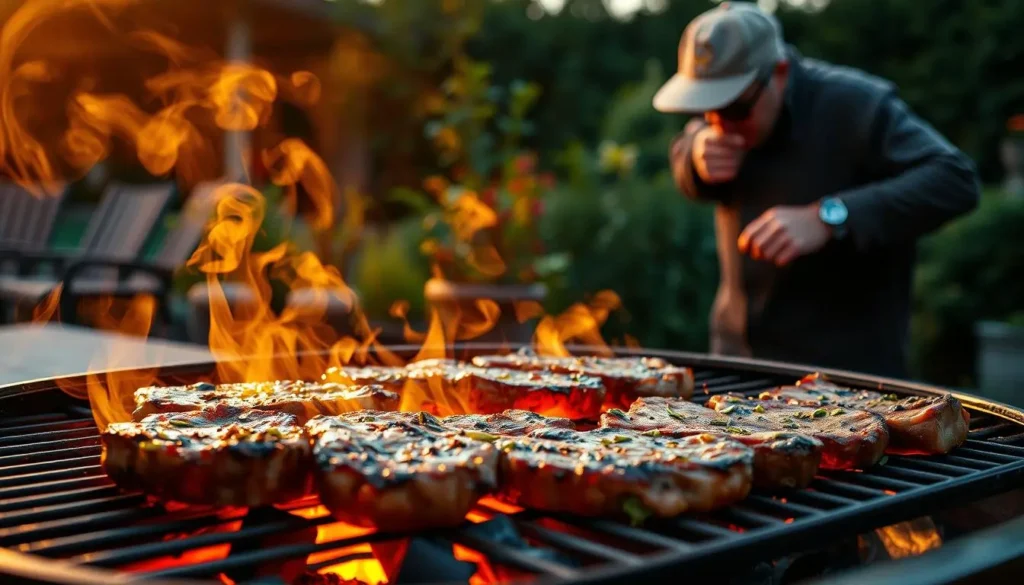
Use a thermometer to ensure the internal temperature reaches your desired level of doneness. A perfectly seared steak has a crispy crust on the outside and a juicy interior.
Grilling Perfect Chicken and Fish
Grilling chicken and fish can be challenging, but with the right techniques, you can achieve perfect results. For chicken, make sure to marinate it before grilling, and cook it over medium heat to prevent burning.
For fish, use a fish basket or grill mat to prevent it from sticking to the grates, and cook it over medium-high heat for a crispy exterior.
Adding Wood Chips for Custom Flavor Profiles
Adding wood chips to your charcoal grill can enhance the flavor of your food and provide a custom flavor profile. Different types of wood chips, such as hickory or apple, can impart unique flavors to your food.
To use wood chips, simply soak them in water, then add them to the charcoal or a smoker box. Experiment with different wood chip flavors to find the one that works best for you.
Troubleshooting and Maintenance for Your Charcoal Grill
A well-maintained charcoal grill is the secret to consistently delicious outdoor cooking. To achieve this, you need to focus on troubleshooting common issues, regular cleaning, and safe handling practices.
Fixing Common Grilling Problems
Common grilling problems can often be resolved with simple troubleshooting. For instance, if your grill is not heating evenly, check that your charcoal is distributed properly and that your vents are not clogged. If you’re experiencing flare-ups, try adjusting the vents to reduce oxygen flow or moving the food to a cooler part of the grill.
Seasonal Cleaning and Maintenance
Regular cleaning is essential for maintaining your charcoal grill. At the start of each grilling season, perform a deep clean by scrubbing the grates and removing any ash or debris from the previous season. Check for any worn-out parts and replace them as necessary.
| Maintenance Task | Frequency |
| Clean grates | After each use |
| Deep clean grill | Start of each season |
| Check for worn-out parts | Start of each season |
Safe Handling and Storage Practices
Safe handling and storage are crucial for preventing accidents. Always keep a fire extinguisher nearby when grilling, and ensure your grill is placed on a stable, heat-resistant surface. When storing your charcoal grill, make sure it is completely cool and cover it to protect it from the elements.

Conclusion
By following the expert charcoal grill advice outlined in this article, you’re well on your way to mastering the art of charcoal grilling. Charcoal grill tips such as choosing the right charcoal, setting up your grill, and controlling temperature are essential for achieving perfect results.
As you continue to practice and refine your skills, you’ll find that charcoal grilling becomes second nature. With patience and persistence, you’ll be able to achieve that perfect smoky flavor and tender texture that makes charcoal grilling so beloved.
Now that you’ve learned the fundamentals and advanced techniques, it’s time to put them into practice. Experiment with new recipes, try different types of charcoal, and fine-tune your grilling skills to become a true charcoal grilling master.
FAQ
What type of charcoal is best for grilling?
The best type of charcoal for grilling depends on your personal preference and grilling style. Lump charcoal is known for its high heat and smoky flavor, while briquette charcoal provides a more consistent burn.
How do I preheat my charcoal grill properly?
To preheat your charcoal grill, light the charcoal using a chimney starter or lighter fluid, and then wait until the coals are covered in a layer of gray ash. This indicates that the charcoal is ready for grilling.
How do I control the temperature on my charcoal grill?
To control the temperature on your charcoal grill, adjust the vents to regulate airflow. Opening the vents increases the temperature, while closing them decreases it. You can also create heat zones by adjusting the charcoal distribution.
Can I use wood chips on my charcoal grill?
Yes, you can use wood chips on your charcoal grill to add custom flavor profiles to your food. Soak the wood chips in water for at least 30 minutes before grilling, and then place them on the coals to infuse your food with smoky flavor.
How do I clean and maintain my charcoal grill?
To clean and maintain your charcoal grill, scrape the grates after each use, and perform a deep clean seasonally. Check for worn-out parts and replace them as needed, and store your grill in a dry, protected area during the off-season.
What are some common grilling problems and how can I fix them?
Common grilling problems include uneven cooking, flare-ups, and food sticking to the grates. To fix these issues, adjust your heat zones, trim excess fat from meat, and oil your grates before grilling.
Is it safe to store charcoal in my garage or shed?
No, it’s not recommended to store charcoal in your garage or shed, as it can be a fire hazard. Store charcoal in a well-ventilated, dry area away from flammable materials.
Can I achieve a smoky flavor with a charcoal grill?
Yes, you can achieve a smoky flavor with a charcoal grill by using wood chips or chunks, and by cooking low and slow. This allows the smoke to penetrate the food and infuse it with a rich, smoky flavor.

